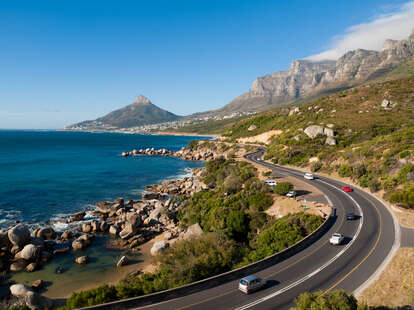South Africa's Garden Route Is One of the Best Road Trips on the Planet
Gear up for lush landscapes, scenic vistas, seaside retreats, and all the wildlife.
If the world was divided between those who prefer green spaces and those who prefer blue spaces, the confluence of those desires would be found at the tip of South Africa. Taking its name from the verdant forests that line the Indian Ocean’s edge, the Garden Route captivates both tourists and South Africans alike. The 124-mile coastal drive stretches from the harbor town of Mossel Bay to the mouth of Storms River, offering up a plenitude of sights along the way, from sprawling vineyards, inland lagoons, and elephant-laden safaris to massive gorges framed by seafront horizons. It’s the kind of road trip where every passing scene is likely to jolt you out of your seat.
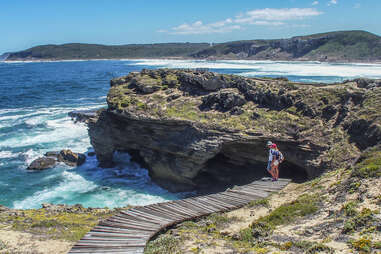
What to know before hitting the road
The majority of the Garden Route follows the N2, South Africa’s version of the Pacific Coast Highway. Along the way, you’ll pass through beachside cities like Cape Town, Knysna, Plettenberg Bay, and Gqberha, as well as natural escapes like Addo Elephant National Park and Tsitsikamma National Park. Depending on your itinerary, the journey can range from one to two weeks, so make sure you’ve allotted yourself plenty of time to explore around the bush.
The beauty of the Garden Route is a year-round spectacle, so when you choose to go depends on your adventure of choice. Summer in South Africa—roughly from November to April—brings warm, dry weather, ideal for beach-going and other outdoor activities, but with it also comes peak tourist season. The winter runs from July to September, and offers fewer crowds and milder weather. The sweet spot might just be the shoulder seasons of spring (September to November) and autumn (March to May).
September is an especially excellent time for spotting whales and catching the region’s otherworldly fynbos flowers in full bloom. And since the rainy season comes to a close around the end of August, the Western Cape will be at its greenest, while hiking the infamous Otter Trail in autumn promises pleasantly cool mornings. Keep in mind, however, that rainfall is unpredictable in the Rainbow Nation, so you’re likely to get hit with some drops no matter the time of year.
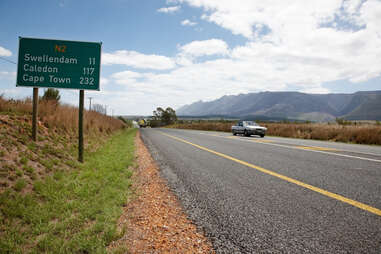
How to navigate the Garden Route
While there are a few airports dotting the Garden Route, Cape Town International Airport offers the best starting point. Cape Town-based Drive South Africa, which partners with car rental companies like Avis and Hertz, is a reputable agency for booking a rental, especially if you’re hoping to get an off-road vehicle to tackle some rugged terrain. You’ll need your passport, driver’s license, and credit card—no international driver’s license necessary, unless yours isn’t in English.
If the idea of driving yourself through safari land and mountain passes seems a bit daunting, consider booking a trip with a tour company like Contiki, which offers an expert-led, seven-day trip covering the very best of the Garden Route. All accommodations and experiences—from visiting Stellenbosch wineries to kayaking through Storms River Gorge—are included in the package, so you won’t have to worry about booking a thing.
Whether you’re cruising by your lonesome, or placing your fate in the hands of a local guide, here’s everything you absolutely can’t miss along South Africa’s magical Garden Route.
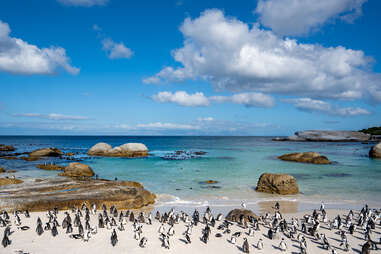
Get to know the locals in the Mother City
While the Garden Route officially begins in Mossel Bay, consider spending a night or two in Cape Town, home to the rightfully touristy V&A Waterfront, towering Table Mountain, and a cluster of choice surf spots. While it’s a bit of a detour from central Cape Town, Boulders Beach boasts one of the last colonies of African penguins in the world. Not only is the beach itself a sight to behold—a hidden cove sheltered by massive boulders—the peaceful resident penguins, dispersed around a visitor-friendly boardwalk, remain delightfully unbothered.
On the cultural front, choose from the technicolor architecture of the Bo Kaap Museum or the contemporary art of Zeitz MOCCA. And if you’re looking for a way to commence the trip, Cape Town happens to be a certified all-day party town, with spots like Caprice and Modular at the ready to host a good time.
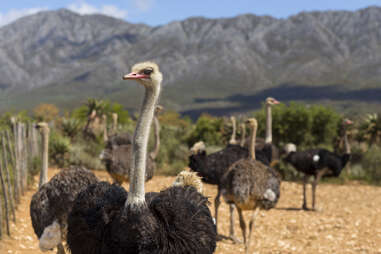
Make your way to the Ostrich Capital of the World
Next up: the Klein Karoo, a desert-like region situated between the Swartberg and Outeniqua Mountains. The principal town, Oudtshoorn, is known for having the world’s largest ostrich population. It rose to prominence during the 1880s and early-1900s, when ostrich feathers were as valuable as diamonds. Today, you can visit the Art Nouveau-style homes of the former feather barons before paying a visit to the big birds at one of the many ostrich farms lining the road.
Equally impressive are the Cango Caves, a 20-million-year-old series of chambers hidden within limestone rocks. Tour through the psychedelic stalagmites and stalactites, and if you’re feeling especially adventurous, crawl and slide your way through the narrow tunnels. To end the day, head to Buffelsdrift Game Lodge, where dinner might come with a show: hippos dipping in and out of the estate’s adjacent watering hole. While you’re there, make sure you try the bobotie, a traditional Cape Malayan dish of venison, egg custard, and papadum.
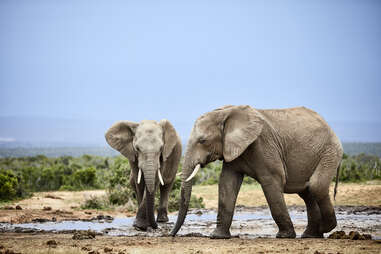
Rub elbows with elephants in Addo
Get an early start from Oudtshoorn and head east to Addo. Though not officially on the Garden Route proper, this elephant-crazed town on the Eastern Cape is worth the detour. You’re looking at about a five-hour drive, so schedule in a pit stop at The Verandah Coffee Shop, a one-of-kind roadside cafe in Steytlerville that triples as a wildlife rescue center (you might see a fox or two) and a vintage sports car museum.
Addo Elephant National Park is swarming with more than 600 elephants, as well as other members of the Big Five like lions, rhinos, and buffalo. You’ll also find some rare antelope species roaming around—including the greater kudu, red hartebeest, and eland—plus, if you look closely, groups of flightless dung beetles exclusive to Addo. The park is massive—the third largest game reserve in South Africa, in fact—and it’s best explored from the driver’s seat of your car. Pull up alongside a watering hole, and you're bound to see multiple gentle giants taking a few sips.
After you’ve had your fill of gazing at animals, point your GPS about 30 minutes southwest to Gberha. Formerly known as Port Elizabeth, this Eastern Cape seaport was recently renamed to reflect its Khoi-San and Xhosa heritage. If time permits, end the day admiring the sunset at Sardinia Bay Beach or walking along Route 67, a trail of public art installations that celebrate Nelson Mandela’s 67-year quest to end Apartheid.
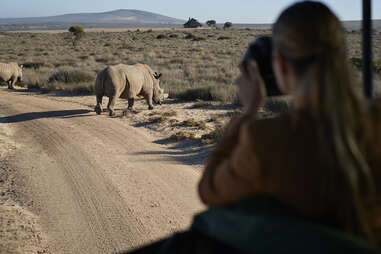
Go for a second serving of safari then try seafood in Knysna
Any seasoned guide will tell you that when it comes to spotting wildlife, nothing is guaranteed—that’s why it’s a good idea to increase your luck by tacking on a second day of game drives. Thankfully, private game reserves on the Eastern Cape provide some of South Africa’s best safari opportunities thanks to their diverse ecosystems.
Check lions and cheetahs off your list at Amakhala Game Reserve, then later enjoy lunch at one of the area’s swanky lodges. Afterwards, turn the car around and travel west to the town of Knysna, widely known as the Jewel of the Garden Route. The seaside village is famous for its oysters, so make a beeline for the bivalves at places like The Drydock or 34 South.
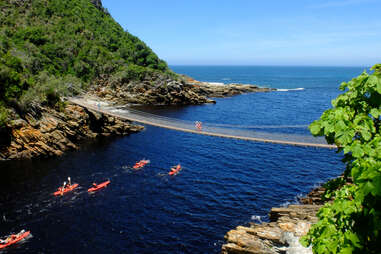
Set sail in Plettenberg Bay, then paddle beneath the Storms River Bridge
From Knysna, drive 30 minutes east to jaw-dropping Plettenberg Bay. One look at the pristine mansions and white sand beaches, and you’ll understand why this seaside resort, nicknamed “Plett” by locals, is one of the most affluent boroughs in South Africa. The area is best seen from the water, though, so book yourself a boat and set out on a marine safari. Depending on the time of year, you might see Southern Right whales, Bottlenose dolphins, or Cape fur seals splashing about the waves.
Your next stop is Tsitsikamma National Park , a.k.a. the garden of the Garden Route. Here, dramatic currents sculpt white foamy shores flanked by mountains bursting with gorgeous flora and fauna. Taking its name from the Khoi-San term for “place of abundant water,” this pocket of natural splendor is famous for the suspension bridge that swings over the Storms River, as well as the arduous Otter Trail, a five-day trek that culminates in the village of Nature Valley. But there’s so much more to the park, from zip lining across Tsitsikamma Falls to observing seabirds soaring through the rocky ravines. If you only have time for a snapshot of what Tsitsikamma has to offer, make the most of it by renting a kayak and paddling down the breathtaking Storms River Gorge.
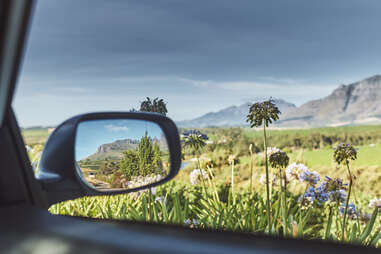
Pet some sharks in Hermanus then sip your way through Stellenbosch
Entering into the university town of Stellenbosch marks your return to Cape Town, but don’t end your trip without a bit of revelry. Before you engage in some wine-soaked fun, stop at Hermanus to pay a visit to the South African Shark Conservancy. There, you can pet some local sharks while learning about the many ways the nonprofit organization is working to save endangered species. Afterwards, take a moment to poke around the charming seaside town’s roster of antique shops, art galleries, and restaurants. But don’t linger too long, because vineyard-hopping lies ahead.
Along with the Paarl and Franschhoek Valleys, the oak-lined town of Stellenbosch is part of the Cape Winelands, a winemaking region with more than 100 venues including standouts like Dornier Wine Estate, Blaauwklippen, and Middelvlei. You can’t leave without trying a glass of South Africa’s signature pinotage, a cross between pinot noir and cinsault. Spend the rest of the afternoon—or the next few days—romping through the scenic vineyards, then retire for a good night’s sleep. You’re due back in Cape Town in the morning.
